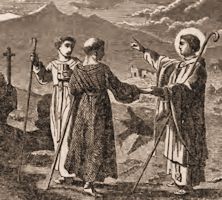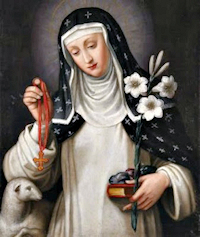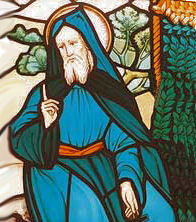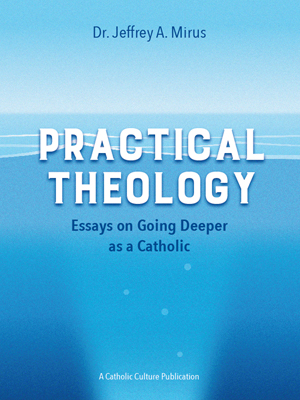Easter: April 20th
Monday of the Third Week of Easter (Optional Memorial of St. Beuno in Wales)
Other Commemorations: St. Beuno (RM and Opt Mem in Wales); St. Marcellinus, Bishop (RM); St. Agnes of Montepulciano, Virgin (RM); St. Anicetus, Pope (RM)
» Enjoy our Liturgical Seasons series of e-books!
The Church in Wales is celebrating the feast of St. Beuno, one of its greatest saints. He was a wonder-worker and aristocrat, monk and master of monks, patriot, challenger of tyrants — that was the medieval picture of the man which is reflected in his Life, and which survives, carved in stone on the fourteenth century pulpit of the Black Monks of Shrewsbury.
St. Beuno
Abbot of Clynnog, d. 640, was, according to the "Bucced Beuno," born in Powis-land and, after education and ordination in the monastery of Bangor, in North Wales, became an active missioner, Cadvan, King of Gwynedd, being his generous benefactor. Cadwallon, Cadvan's son and successor, deceived Beuno about some land, and on the saint demanding justice proved obdurate. Thereupon, Cadwallon's cousin Gweddeint, in reparation, "gave to God and Beuno forever his township" where the saint (c. 616) founded the Abbey of Clynnog Fawr (Carnarvonshire).
Beuno became the guardian and restorer to life of his niece, the virgin St. Winefride, whose clients still obtain marvelous favors at Holywell (Flintshire). He was relentless with hardened sinners, but full of compassion to those in distress. Before his death "on the seventh day of Easter" he had a wondrous vision. Eleven churches bearing St. Beuno's name, with various relics and local usages, witness to his far-reaching missionary zeal.
—Catholic Encyclopedia
Patronage: Diseased cattle; sick animals; sick children
Symbols and Representation: Restoring the head of Saint Winifred.
Highlights and Things to Do:
- Read more about St. Beuno:
- Read about the history of Shrewsbury Abbey.
- His tomb and shrine are located at Clynnog Fawr in Northwest Wales.
St. Marcellinus
 St. Marcellinus was born in Africa, of a noble family; accompanied by two bishops, Vincent and Domninus, he went over into Gaul, and there preached the Gospel, with great success, in the neighborhood of the Alps.
St. Marcellinus was born in Africa, of a noble family; accompanied by two bishops, Vincent and Domninus, he went over into Gaul, and there preached the Gospel, with great success, in the neighborhood of the Alps.
He afterwards settled at Embrun, where he built a chapel in which he passed his nights in prayer, after laboring all the day in the exercise of his sacred calling. By his pious example as well as by his earnest words, he converted many of the heathens among whom he lived.
He was afterwards made bishop of the people whom he had won over to Christ, but the date of his consecration is not positively known. Burning with zeal for the glory of God, he sent Vincent and Domninus to preach the faith in those parts which he could not visit in person.
He died at Embrun about the year 374, and was there interred. St. Gregory of Tours, who speaks of Marcellinus in terms of highest praise, mentions many miracles as happening at his tomb.
—Excerpted from Lives of the Saints, by Alban Butler, Benziger Bros. ed. [1894]
Highlights and Things to Do:
- Read more about St. Marcellinus:
- St. Marcellinus' relics were destroyed during the anti-religious sentiments of the French Revolution.
St. Agnes of Montepulciano
 A Dominican nun, Agnes (1268 – 1317) was renowned for her diligence in prayer and her extraordinary charity. Although born of a wealthy family in Gracchiano, Italy, she believed that charity is the only way to acquire the virtue of humility: there is no humility without charity; the one nourishes the other. She first joined the Sisters of the Sack (so-called because of their rough clothes) in Montepulciano. But when a new foundation was established in Proceno, Agnes was sent there as housekeeper; later she served as bursar and superior. Meanwhile, her austerities and her visions of Christ, Mary, and the angels had become so well known that the citizens of Montepulciano invited her to return. She did so and founded a convent in premises formerly used as brothels. Because she sought perfection according to the way of St. Dominic, she placed the convent under the direction of the Dominicans, and it grew and prospered.
A Dominican nun, Agnes (1268 – 1317) was renowned for her diligence in prayer and her extraordinary charity. Although born of a wealthy family in Gracchiano, Italy, she believed that charity is the only way to acquire the virtue of humility: there is no humility without charity; the one nourishes the other. She first joined the Sisters of the Sack (so-called because of their rough clothes) in Montepulciano. But when a new foundation was established in Proceno, Agnes was sent there as housekeeper; later she served as bursar and superior. Meanwhile, her austerities and her visions of Christ, Mary, and the angels had become so well known that the citizens of Montepulciano invited her to return. She did so and founded a convent in premises formerly used as brothels. Because she sought perfection according to the way of St. Dominic, she placed the convent under the direction of the Dominicans, and it grew and prospered.
St. Agnes of Montepulciano may be best known for an incident that occurred many years after her death. About seventy years after Agnes died, St. Catherine of Siena made a pilgrimage to the shrine of this revered Dominican foundress. St. Catherine bowed to kiss Agnes’ foot, the saint raised it up toward her. Catherine may not have been totally surprised, as miraculous characteristics had surrounded Agnes’ life.
This “little lamb” was born not far from Montepulciano in 1268. She expressed a desire to give her life to God and practiced pious exercises from an early age. Now and then, her parents gave in to her requests to visit the various convents in town. On one such occasion, Agnes and her mother were passing a house of ill repute, when a flock of crows suddenly descended upon her, pecking and scratching the little girl. Her mother remarked that the crows represented demonic forces threatened by her purity. Indeed, years later, Agnes would be asked to found a convent on that very spot.
In her teens, Agnes joined the Franciscans in Montepulciano and rose to become its prioress. Small white flakes in the form of crosses fell gently from the heavens in celebration. It is said that the sisters have preserved some of these until today. In 1306, God inspired Agnes to found a Dominican convent with three stones given her by the Blessed Mother in honor of the Trinity. The Blessed Mother had visited Agnes many times. On one of these occasions, she allowed Agnes to hold the Christ Child, but Agnes showed great reluctance in giving him back.
Toward the end of her life, Agnes sought healing from some famous springs. Although she did not receive healing herself, her prayers effected the resurrection of a child who had drowned in the springs. In 1317, Agnes died in Montepulciano and received her long-awaited reward.
—Excerpted from Dominican Sisters of St. Cecilia Congregation
Symbols and Representation: Dominican nun gazing at the Cross with a lily at her feet; Dominican nun holding a model of Montepulciano, Italy; Dominican nun holding the Christ child; Dominican nun with Saint Catherine of Siena; Dominican nun with the Virgin and Child appearing to her; Dominican abbess with a lamb, lily, and book; Dominican with the sick who were healed at her tomb
Patronage: City of Siena, Italy
Highlights and Things to Do:
- Read more about St. Agnes:
- See some artistic renderings of St. Agnes.
- Her relics are in the Church of St. Agnes in Montepulciano. Her body is said to be incorrupt.
- St. Robert Bellarmine is also from Montepulciano, so there can be overlapping of food and drink ideas for both saints. There is a particular Montepulciano wine that would be perfect for St. Agnes (and St. Robert).
St. Anicetus
 Pope Anicetus, St. Peter's tenth successor (154-165), ruled at a time when many noteworthy events transpired in the Church of God. It was the golden age of Gnosticism, and its chief proponents, Valentine and Marcion, had come to Rome. From the Orient Polycarp arrived to discuss the question regarding the day for celebrating Easter. Among other illustrious men in Rome at the time were Justin Martyr (cf. April 14), who took the occasion to write his second apology and thus precipitated his martyrdom; and the renowned Jewish Christian scholar, Hegesippus. During the pontificate of Pope Anicetus the Church suffered persecution under the Emperor Marcus Aurelius. There is extant a decree in which Anicetus forbade his clergy the vain and frivolous grooming of their hair. His grave is near that of St. Peter in the Vatican.
Pope Anicetus, St. Peter's tenth successor (154-165), ruled at a time when many noteworthy events transpired in the Church of God. It was the golden age of Gnosticism, and its chief proponents, Valentine and Marcion, had come to Rome. From the Orient Polycarp arrived to discuss the question regarding the day for celebrating Easter. Among other illustrious men in Rome at the time were Justin Martyr (cf. April 14), who took the occasion to write his second apology and thus precipitated his martyrdom; and the renowned Jewish Christian scholar, Hegesippus. During the pontificate of Pope Anicetus the Church suffered persecution under the Emperor Marcus Aurelius. There is extant a decree in which Anicetus forbade his clergy the vain and frivolous grooming of their hair. His grave is near that of St. Peter in the Vatican.
Highlights and Things to Do:
- Read more about Pope St. Anicetus:
- According to tradition, Pope St. Anicetus has been listed as a martyr for centuries during the reign of Emperor Lucius Verus, but there is no historical evidence of his martyrdom.
- Pope St. Anicetus' remains were transferred from Vatican Hill to the cemetery of Callistus. Later his sarcophagus which may once have contained remains is extant in the Palazzo Altemps.
- Listen to Mike Aquinina's Way of the Fathers podcast of St. Polycarp and the Social Network.








